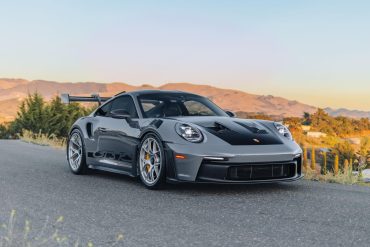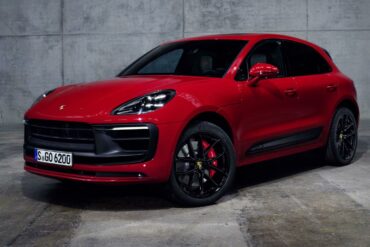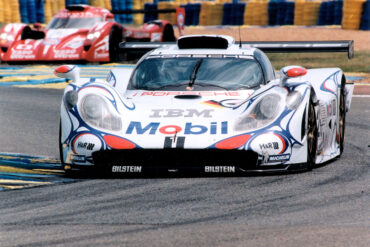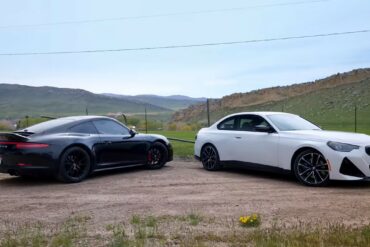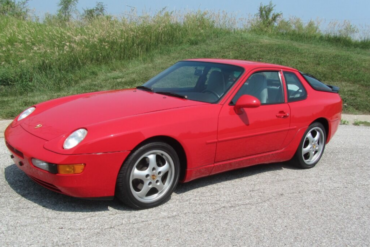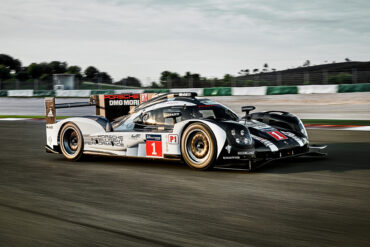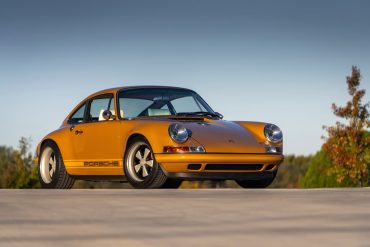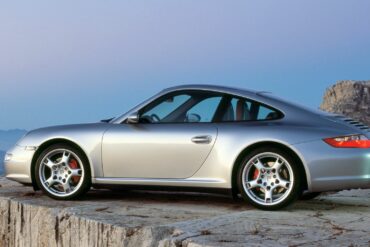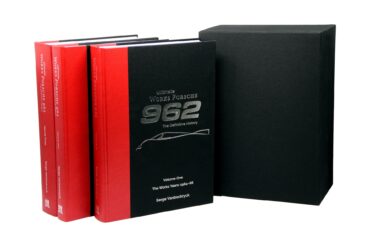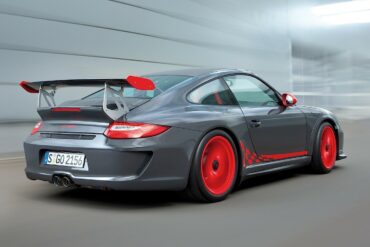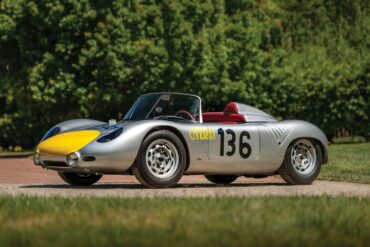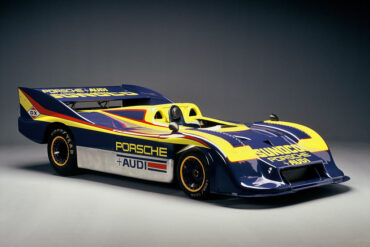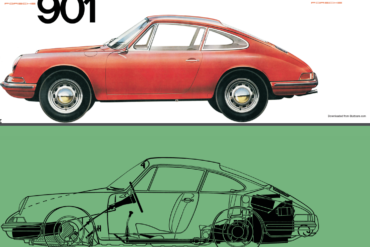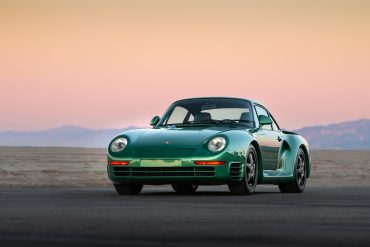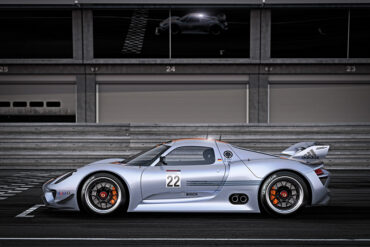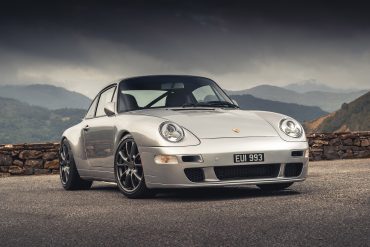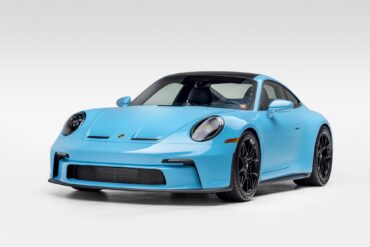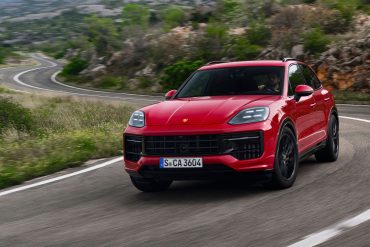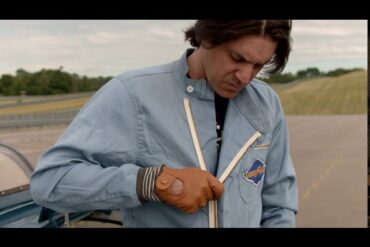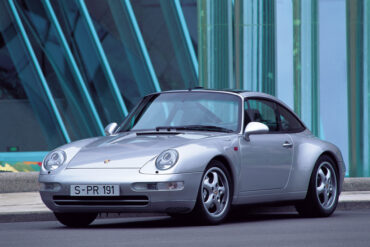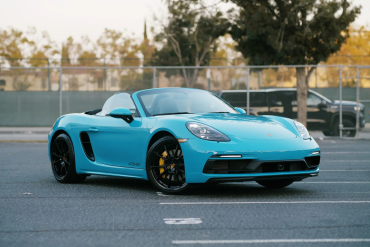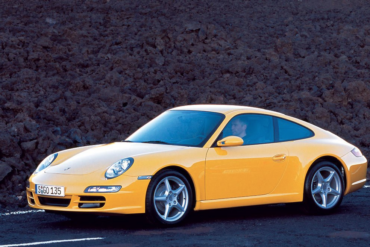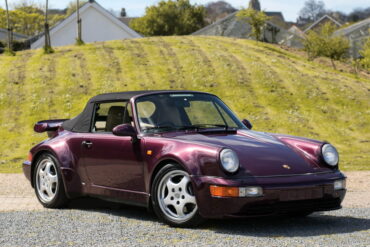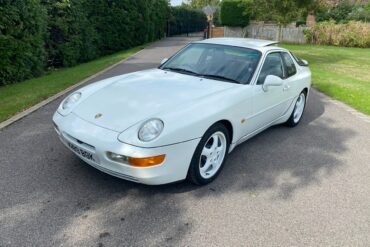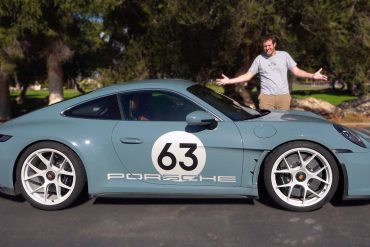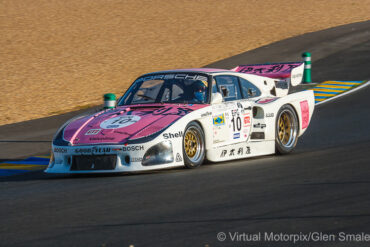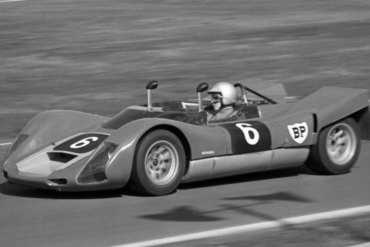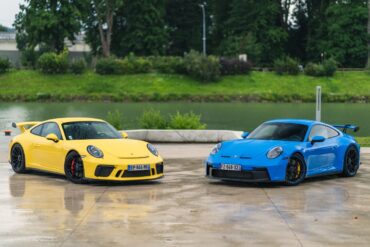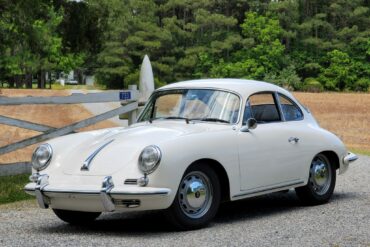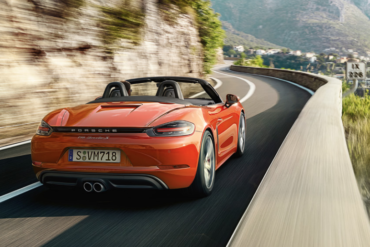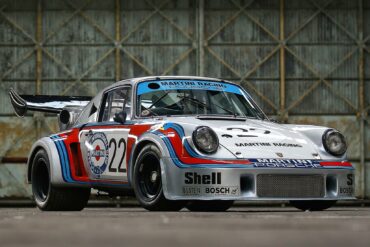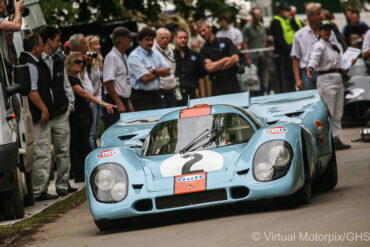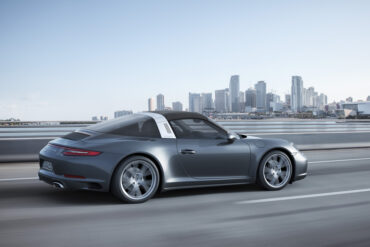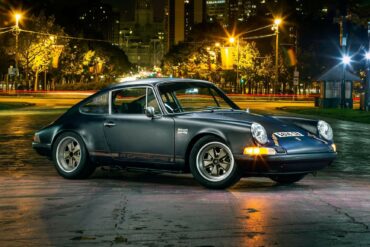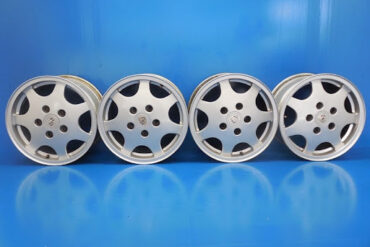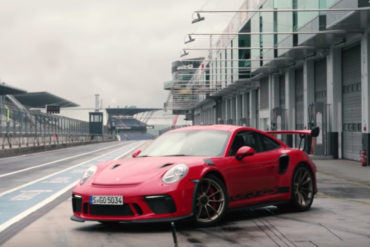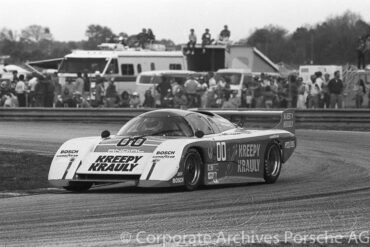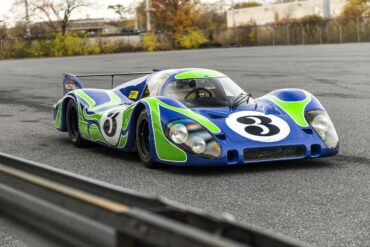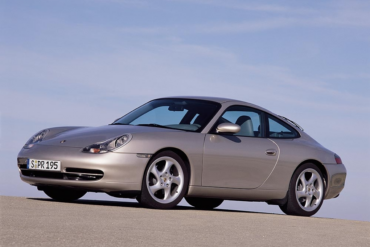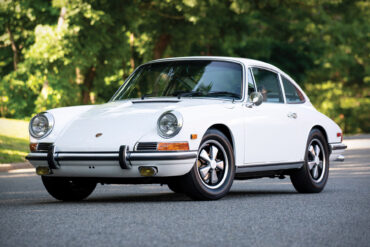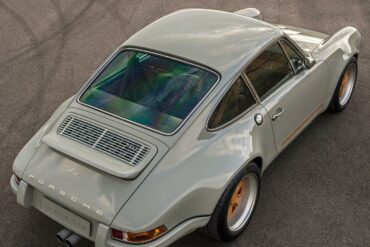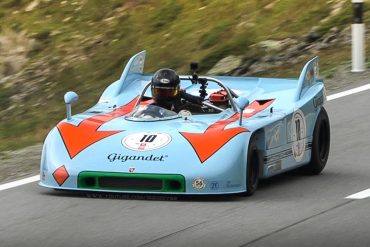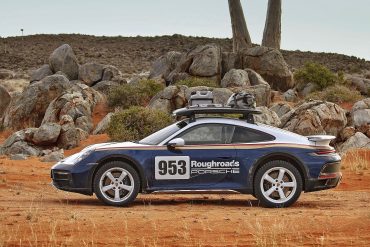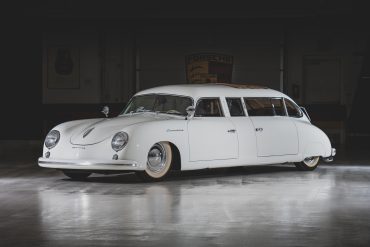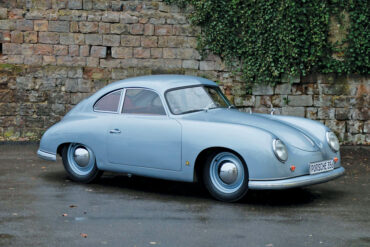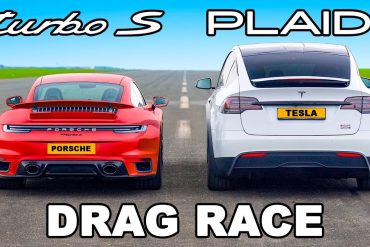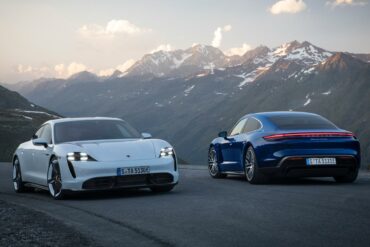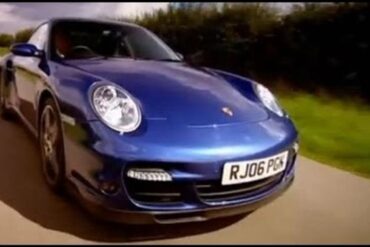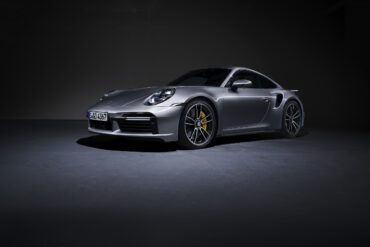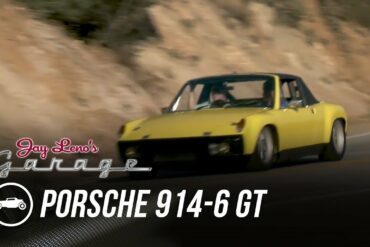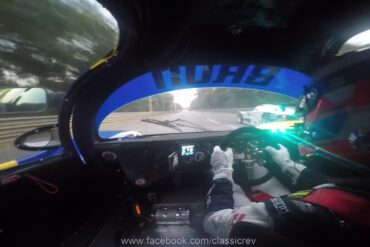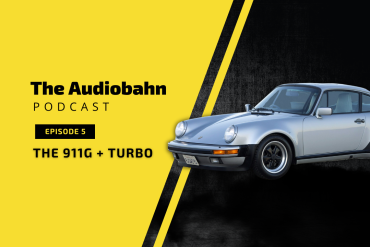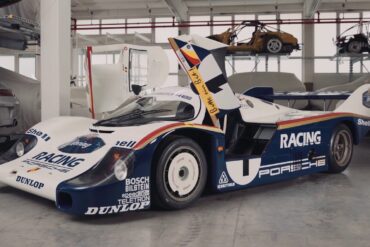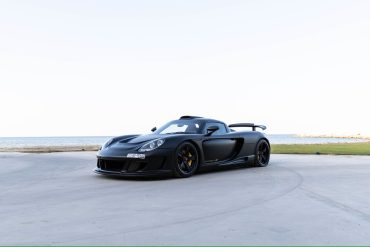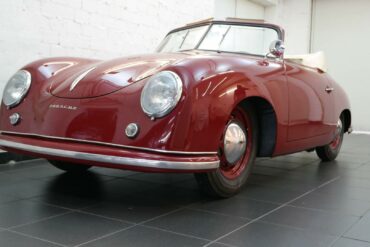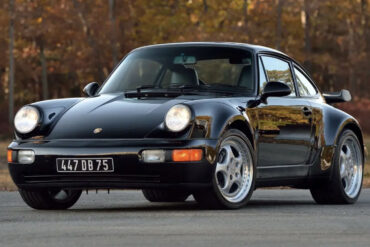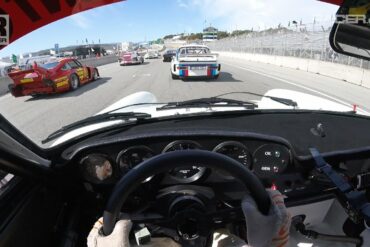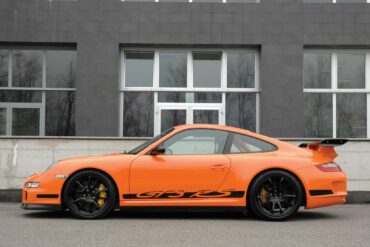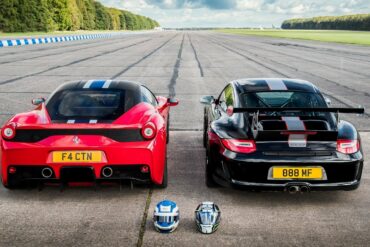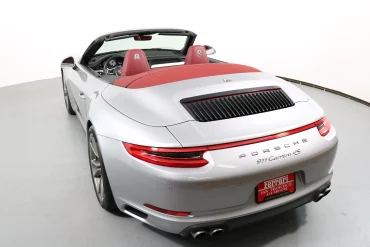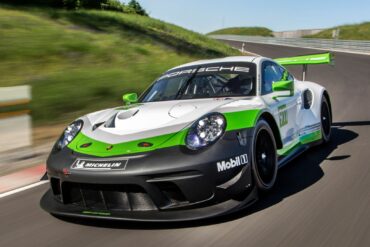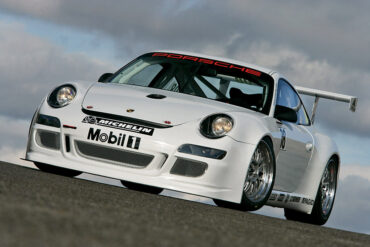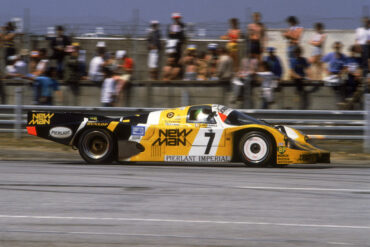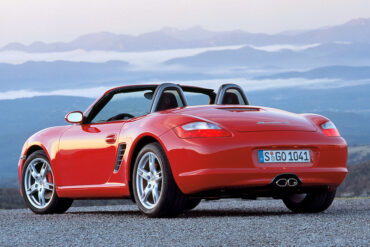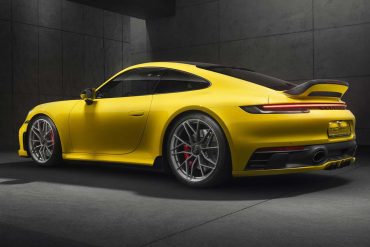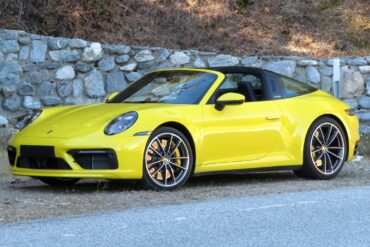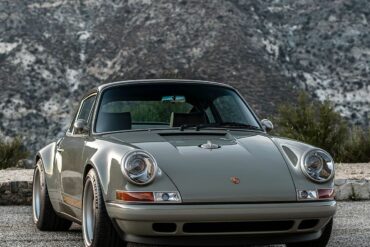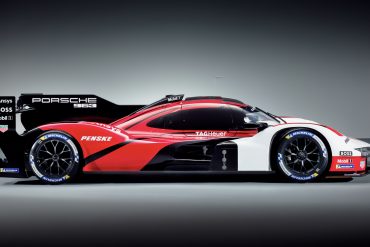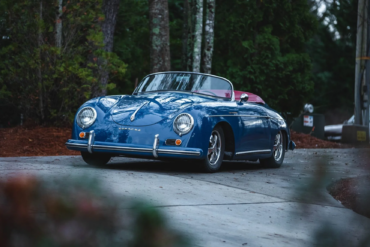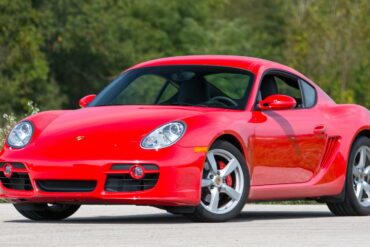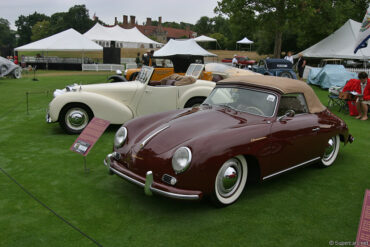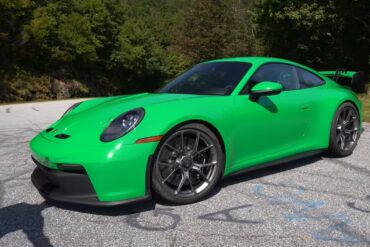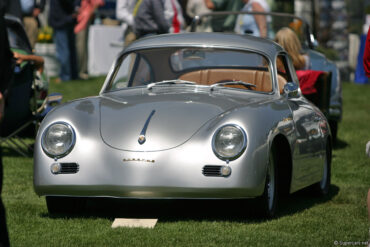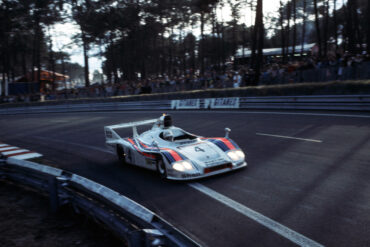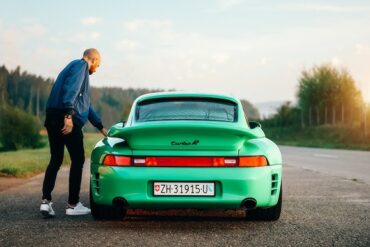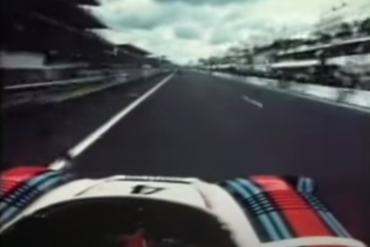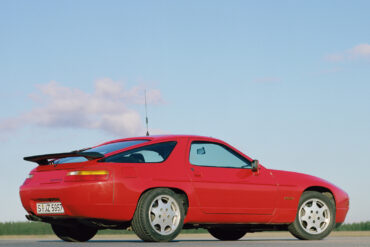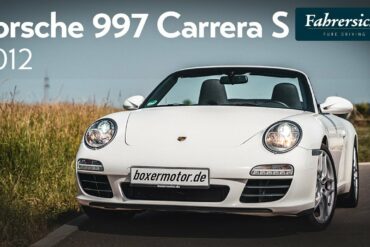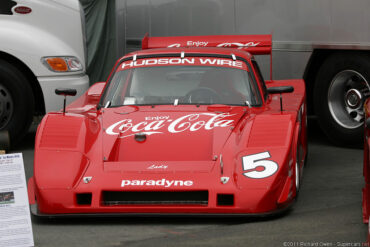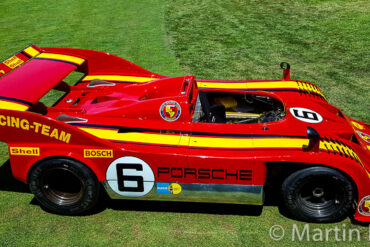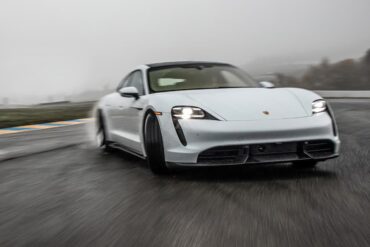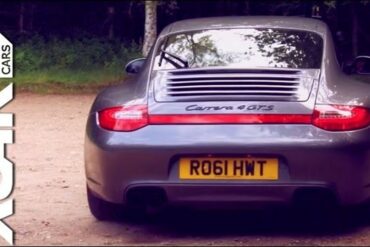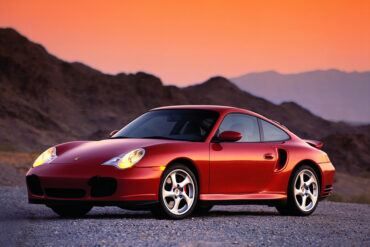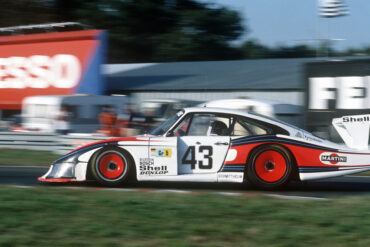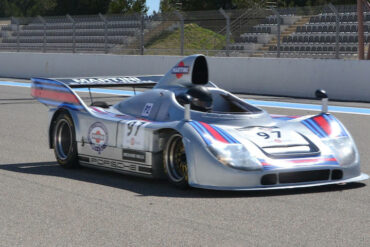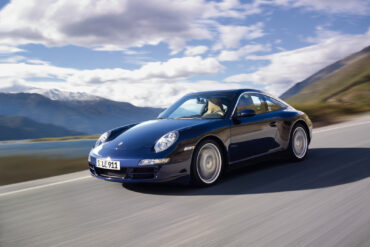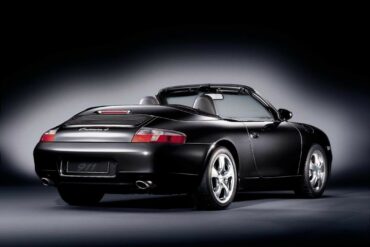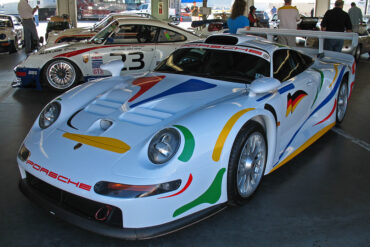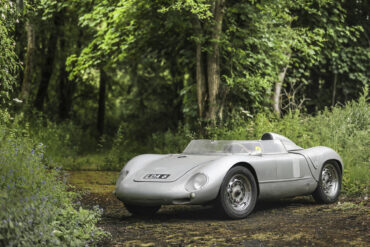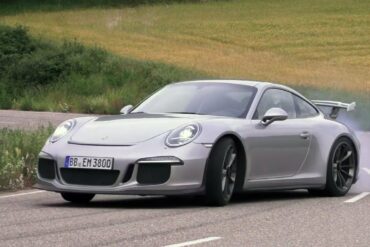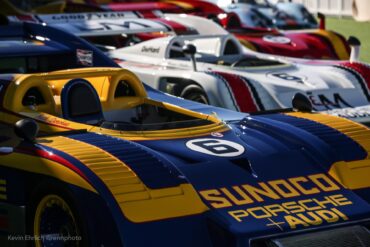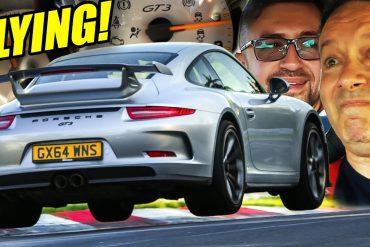The 2023 Porsche 911 GT3 RS features a practical and aggressive exterior design adapted from the Le Mans class-winning 911...
Porsche Models
All
- Porsche Cayman 987 (2nd Gen)
- Porsche 924
- Porsche Cayenne 955 (1st Gen)
- Porsche Cayenne
- Porsche Carrera GT
- Porsche Boxster Concept
- Porsche 911
- Porsche 959
- Porsche 944
- Porsche 928
- Porsche 962
- Porsche RS Spyder
- Porsche 917K
- Porsche 914
- Porsche 918
- Porsche Cayman 981 (3rd Gen)
- Porsche Cayenne 957 (1st Gen)
- Porsche Boxster 986 (1st Gen)
- Porsche Boxster 987 (2nd Gen)
- Porsche 718 Cayman 982 (4th Gen)
- Porsche Cayenne 958 (2nd Gen)
- Porsche 356 Pre-A
- Porsche Boxster 981 (3rd Gen)
- Porsche 356 A
- Porsche 718 Boxster 982 (4th Gen)
- Porsche 356 B
- Porsche 356 C
- Porsche 968
- Porsche Panamera
- Porsche Panamera 970 (1st Gen)
- Porsche Panamera 971 (2nd Gen)
- Porsche Boxster
- Porsche Cayman
- Porsche Macan
- Porsche Taycan
- Porsche 912
- Porsche 919
- Porsche 956
- Porsche 2708 Indy
- Porsche Type 64
- Porsche 918 RSR Concept
- Porsche 918 Spyder
- Porsche 918 Concept
- Porsche 918 Spyder Prototype
- Porsche 917
- Porsche Race Cars
- 911 Carrera RS 2.7
- Porsche 550
- Porsche 718
- Porsche 901 (911)
- Porsche Concept Cars
- Porsche 904
- Porsche 906
- Porsche 907
- Porsche 908
- Porsche 910
- Porsche 911 (F-Series)
- Porsche 911 (991)
- Porsche 911 (G-Series)
- Porsche 911 (964)
- Porsche 911 (993)
- Porsche 911 GT1 Race
- Porsche 911 GT1 Street
- Porsche 911 (996)
- Porsche 911 (997)
- Porsche 916
- Porsche 919 Hybrid
- Porsche 934
- Porsche 934/5
- Porsche 935
- Porsche 936
- Porsche Mission E
- Porsche 928
- Porsche 928 S
- Porsche 928 S4
- Porsche 928 GT
- 911 Speedster Concept
- Porsche 928 GTS
- Porsche 928 Specials
- Porsche 928 H50
- Porsche 935 Tribute
- Porsche 928 CS/SE
- Porsche 597
- Porsche Mission E Cross Turismo
- Porsche 551
- Porsche Concept 917
- Porsche 911 (992)
- Porsche Sport Tourer Electric
- Porsche Le Mans Living Legend
- Porsche 960 Turismo Concept
- Porsche 919 Street
- Porsche 904 Living Legend
- Porsche 906 Living Legend
- Porsche 911 Vision Safari Concept
- Porsche Bergspyder Concept
- Porsche Macan Vision Safari
- Porsche Vision 916
- Porsche Vision 918 RS
- Porsche Vision 920
- Porsche Vision E
- Porsche 917 16-Cylinder Prototype
- Porsche 959 Gruppe B
- Porsche Carrera GT Concept
- Porsche Tapiro Concept
- 718 Cayman GT4 Rallye
- Porsche Taycan 4S
- Porsche Taycan Turbo
- Porsche Taycan Turbo S
- Porsche Typ 360
- Porsche 645 Spyder
- Porsche 550 Coupé (Prototype)
- Porsche 550 Spyder (Prototype)
- Porsche 550 Spyder
- Porsche 550 RS Spyder
- Porsche 550A RS Spyder
- Porsche 787 F1
- Porsche 804 F1
- Porsche 904 Carrera GTS
- Porsche 904/6 Carrera GTS
- Porsche 904/8 Carrera GTS
- Porsche 904 Bergspyder
- Porsche 906 Spyder
- Porsche 906 LH Coupé
- Porsche 965 (911)
- Porsche 942
- Porsche 906 E Carrera 6
- Porsche 959 Prototype
- Porsche 906/8 Coupé
- Porsche 969
- Porsche 906 Carrera 6
- Porsche 989
- Porsche 910 Bergspyder
- Porsche 910 Targa
- Porsche 909
- Porsche C88
- Porsche Panamericana
- Porsche 718 RSK Spyder
- Porsche 718 RS 60 Spyder
- Porsche 718 RS 61 Spyder
- Porsche 718 W-RS Spyder
- Porsche 718 GTR Coupe
- Porsche 718/2 F2
- Porsche 718 RS 61 LM Coupé
- Porsche 718 RSK Mittellenker
- Porsche 907 K
- Porsche 907 LH
- Porsche 908/01 LH Coupé
- Porsche 908/01 K Coupé
- Porsche 908/02 K Spyder
- Porsche 908 K Flunder Spyder
- Porsche 908 LH Flunder Spyder
- Porsche 908/03 Spyder
- Porsche 908/03 Spyder Turbo
- Porsche 919 Hybrid Evo
- Porsche LMP2000
- Porsche 984
- Porsche LMP1-98
- Porsche 961
- Porsche 917 LH-69
- Porsche WSC-95
- Porsche 917 K-69
- Porsche 917 ‘Interserie Spyder’
- Porsche 917 K-70
- Porsche 917 K-71
- Porsche 917 LH-70
- Porsche 917 LH-71
- Porsche 917/20
- Porsche 917/10-71
- Porsche 917/10-72
- Porsche 917/10 Turbo
- Porsche 917/20 Turbo
- Porsche 917/30
- Porsche 914/4 (1.7 L)
- Porsche 914/4 (2.0 L)
- Porsche 914/6 (2.0 L)
- Porsche 914 LE
- Porsche 914/4 (1.8 L)
- Porsche 914/8
- Porsche 914-6 GT
- Porsche 924 (Base)
- Porsche 924 Turbo
- Porsche 924 Carrera GT
- Porsche 924 Carrera GTR
- Porsche 924 Carrera GTS
- Porsche 924S
- Porsche 924 Rallye Turbo
- Porsche 924 Carrera GTP
- Porsche 924 SCCA
- Porsche 944 Coupe
- Porsche 944 S Coupe
- Porsche 944 S2 Coupe
- Porsche 944 S2 Cabriolet
- Porsche 944 Turbo Coupe
- Porsche 944 Turbo S Coupe
- Porsche 944 Turbo Cup
- Porsche 944 Turbo Cabriolet
- Porsche 944 GTP
- Porsche 944 Swiss Special
- Porsche 944 French Special
- Porsche 944 Celebration
- Porsche 944 S2SE
- Porsche 968 Coupe
- Porsche 968 Cabriolet
- Porsche 968 CS Coupe
- Porsche 968 Turbo S
- Porsche 968 Turbo RS
- Porsche 968 Sport
- Porsche 959 Rally
- Porsche 959 Komfort
- Porsche Cayenne 9YA (3rd Gen)
- Porsche 959 Sport
- Porsche Boxster (Base)
- Porsche Boxster S
- Porsche Boxster S Special Edition
- Porsche Boxster Spyder
- Porsche Boxster RS 60 Spyder
- Porsche Boxster GTS
- Porsche Boxster T
- Porsche Cayman (Base)
- Porsche Cayman S
- Porsche Cayman GTS
- Porsche Cayman GT4
- Porsche Panamera Sport Turismo
- Porsche Cayman R
- Porsche Macan 95B (1st Gen)
- Porsche Cayman S Black Edition
- Porsche Macan (Base)
- Porsche Cayman S Sport
- Porsche Macan S
- Porsche Cayman S Design Edition 1
- Porsche Macan GTS
- Porsche Cayman T
- Porsche Macan Turbo
- Porsche Taycan (Base)
- Porsche Cayman GT4 Clubsport
- Porsche Taycan 4
- Porsche 718 Boxster 25
- Porsche Formula E
- 964 Carrera 2
- 964 Carrera 4
- ’30 Jahre’ Anniversary
- 964 Speedster
- 964 Turbo
- 964 Carrera RS
- 964 Carrera Cup
- 964 RSR
- Porsche Cayman GT4 RS
- 993 Carrera
- 993 Carrera 4
- 911 Edition 50
- 911 2.0 Bertone Roadster
- 993 Carrera 4S
- Porsche Macan T
- Porsche Mission R Electric
- 993 Carrera S
- 993 Targa
- Porsche Vision Gran Turismo
- 992 Sport Classic
- 993 Turbo
- 993 Carrera RS
- 996 Carrera
- 993 GT2
- 996 Carrera 4
- 992 America Edition 911
- 993 Carrera Cup
- 996 Targa
- 996 Carrera 4S
- Porsche 963
- 996 Turbo
- Porsche 718 Cayman GT4 ePerformance
- 996 Turbo S
- 996 GT3
- 996 GT3 RS
- 996 GT2
- 718 Boxster
- 996 GT3 Cup
- 996 GT3 R
- 996 GT3 RSR
- 997 Carrera
- 996 GT3 RS Race
- Porsche 991 (991)
- 997 Carrera S
- 997 Carrera 4
- 997 Carrera 4S
- 997 Targa
- 911 Carrera 3.0 Coupe (G-Series)
- 997 Targa 4S
- 997 Turbo
- 997 Turbo S
- 997 GT2
- 992 Carrera T
- 997 GT2 RS
- 997 Speedster
- 997 Carrera GTS
- 992 Dakar
- 997 Carrera 4 GTS
- 997 GT3 Cup
- 997 GT3 R
- 997 GT3 RSR
- 997 GT3
- 997 GT3 RS
- 997 GT3 R Hybrid
- 991 Carrera
- 991 Carrera 4
- 991 Carrera S
- 991 Carrera 4S
- Porsche 981
- Porsche Vision 357
- 991 Targa 4
- 991 Targa 4S
- 991 Turbo
- 991 Turbo S
- 991 Carrera GTS
- 991 Carrera 4 GTS
- 991 Targa 4 GTS
- Porsche 961
- 991 911 R
- 991 GT3
- Porsche 992 GT2 RS
- 991 GT3 RS
- 991 GT2 RS
- 991 Speedster
- 991 GT3 R
- 991 GT3 Cup
- 991 RSR
- Porsche 962
- 991 Carrera T
- Porsche Cayenne (4th gen)
- 992 Carrera 2
- 992 Carrera 4
- Porsche Type 540 America Roadster
- Porsche 718 Spyder RS
- 992 Carrera S
- 992 Carrera 4S
- 992 Targa 4
- 992 RSR
- 992 Targa 4S
- Porsche Mission X
- 992 Carrera GTS
- 992 Carrera 4 GTS
- 992 Targa 4 GTS
- Porsche RS60 Spyder
- 992 Turbo
- 992 GT3 R
- 992 Turbo S
- 992 GT3
- 992 911 S/T
- 992 GT3 Touring
- 911 (G-Series)
- 992 GT3 RS
- 992 GT2 RS
- 911 Carrera 3.0 (G-Series)
- 992 GT3 Cup
- Porsche Taycan GTS
- Porsche 356 SC
- 911 S (G-Series)
- Porsche Mission X
- 911 SC (G-Series)
- Porsche 992 GT3 R Rennsport
- 911 Carrera RSR 2.8
- 911 S/T
- 911 (Base Model)
- 911 Carrera 3.2 (G-Series)
- 911 SC Safari
- 911 L
- 911 Turbo (930)
- 911 T
- 911 Carrera RSR Turbo 2.1
- 911 Carrera RSR 3.0
- 911 E
- 911 SC San Remo
- 911 S
- Pre-A Speedster
- 911 R
- Porsche 953
- Porsche 356
- 911 Carrera 3.2 Clubsport
- Porsche Panamera (3rd gen)
- 911 SC RS
- 911 Carrera 25th Anniversary
- 911 T/R
- 911 Turbo LE
- 911 Carrera RS 3.0
- Beutler Coupe
- 911 Turbo 2.7
- 911 Carrera 2.7 (G-Series)
- 911 3.2 Speedster
- 911 Carrera Commemorative
- Porsche 911 GT1
- Porsche 99X Electric
- Porsche Macan 4
- 964 Turbo S
- Taycan Turbo GT
Porsche Macan Sales Figures Porsche Macan Sales Numbers (U.S Market) Sales Totals Per Year & Model (coming soon) Sales...
The 1998 GT1 car was a totally rethink and vast upgrade versus the prior year car. 1998 Le Mans 24-hour race In the 1998 jubilee year, the Porsche team celebrated its 16th overall victory in Le Mans with a double win for the 911 GT1 98. On 6th/7th June, the winning car was driven by Laurent Aiello, Allan McNish and Stéphane Ortelli. It was almost 50 years to the day on which the first Porsche sports car saw the light of day.
Everyday Driver compares and contrasts the Porsche 911 Carrera 4S and the BMW M240i. Guess which car comes out on...
Revealed at the 1972 Paris Auto Salon, Porsche revived the Carrera name for its top-tier 1973 911 model, the Carrera...
1994 Porsche 968 Coupe Technical Specifications Engine Type Inline 4 Induction Normally-Aspirated Cooling Water-cooled Valvetrain Double overhead camshafts Injection Port injection...
2016 Porsche 919 Hybrid Pictures...
This Saturday, Mecum Auctions will be offering a beautiful 1990 Porsche 911 Carrera 2 Coupe that has been reimagined by...
Porsche 911 Spare Parts Catalogs (997, 2005 – 2012 Model Year) These official Porsche PET Diagrams and codes for the...
The Porsche 962, following in the footsteps of the already massively successful 956, was introduced in 1984 in response to...
2010 Porsche 911 GT3 RS (997.2) Technical Specifications Engine Type Flat 6 Induction Normally-aspirated Cooling Water-cooled Valvetrain Double overhead camshafts Injection...
Porsche announces Singapore as the location of its 11th Porsche Experience Centre (PEC) worldwide—and simultaneously the world’s first PEC, conceptualized...
For the 1960 season the FIA made changes to the regulation regarding the windscreen and cockpit size. These rules changes together with a larger (1.6-litre) Type 547/3 engine, developing 160 horsepower (120 kW) and a new double wishbone rear suspension brought about the RS 60 model. The RS 60 brought Porsche victory at the 1960 12 Hours of Sebring with a car driven by Hans Herrmann and Olivier Gendebien. 1960 also saw Porsche win the Targa Florio with Hans Herrmann being joined on the winner podium by Jo Bonnier and Graham Hill. z
The final evolution of the 917 was created after Ferdinand Piëch had left the Porsche company in 1972. Two complete 917/30 Can-Am cars with 2500 mm (98.4") wheelbase were made for Roger Penske Enterprises racing team. They were chassis 917/30-002 and 003. The 001 car was not a real 917/30 and was raced in Europe at the Interserie. The Can-Am 917/30 had a 5.4-litre flat 12-cylinder twin-turbo engine which produced so much power that nobody really knew how much.
Porsche 911 Sales Brochures (1st Generation) Clearly going back this far, sales catalogs for Porsche cars are hard to find....
While the 959 was a technical marvel in 1986, in 2018 it is easily beaten by the latest hot hatches....
type Concept / Prototype Car released at 2011 NAIAS built at Germany engineers Wolfgang Hatz engine V8 w/Electric Motor, Lithium-Ion...
The Autoart 993R is a tribute to the driving experience of a 911. It brought together the narrow-bodied, air-cooled 993-series...
A 2023 Porsche 911 GT3 Touring finished in paint-to-sample Olympic Blue. It also features the optional Touring Package in Black,...
At Porsche, the “GTS” designation—short for Gran Turismo Sport—signifies enhanced dynamism and long-distance performance. The Cayenne fundamentally embodies the dual...
Old Soul – The Ford v. Ferrari Porsche 906 A short documentary to bring out the old soul in us...
The Targa was the half-convertible bodywork offered by Porsche for the 911. By removing only a part of the roof and leave the closed-coupe rigid structure. It was offered a better sensation than a sunroof and it wasn't as heavy as a convertible. Unlike the previous Targa generation, the 993 featured a glass panel over the front passengers instead of a fabric one. The rest of the bodywork looked similar to the Carrera. The engine was a completely reworked flat-six, with a 3.6-liter displacement with the VarioCam system, which offered 285 hp. It was mated either with a 6-speed manual or a 4-speed automatic.
Essentially a liaison Boxster version situated between the 718 Boxster GTS and the hardcore 718 Spyder, the Porsche 718 Boxster...
2006 Porsche 911 Carrera (997) Technical Specifications Engine Type Flat 6 Induction Normally-aspirated Cooling Water-cooled Valvetrain Double overhead camshafts Injection...
The Turbo-look Porsche 964 has always been a very desirable automobile, among them 1,532 Carrera 2 Cabriolets constructed worldwide. Within that group, there were some cars that were even more specialized. The Register says six Turbo-look cabriolets were pulled off the production line in Zuffenhausen and transported to the Porsche Exclusive shop in Weissach. Three of these six powerful and luxuriously equipped drop-tops were equipped with left-hand drive for buyers in Germany (Code C00), and the other three were fitted with right-hand drive
1992 Porsche 968 Coupe Technical Specifications Engine Type Inline 4 Induction Normally-Aspirated Cooling Water-cooled Valvetrain Double overhead camshafts Injection Port injection...
Many consider the 2024 Porsche 911 S/T as the ultimate Porsche 911 as it combines the best features from various...
Ultimate Bargain – A Used Porsche Boxster 987 We take you through all the good, bad & weird features on...
Porsche 906 Spyder Specifications Specs 906/8 Spyder “Ollon Villars” Engine: 8-cylinder boxer engine (four-stroke) Displacement: 1981 cc Bore × stroke:...
Porsche 911 GT3 Buyer’s Guide (991 & 992) Over the past 2 decades, the Porsche 911 GT3 models—and their variants,...
A race at the Nurburgring between a Porsche 991 GT3 RS, 992 GT3 MR, Cayman GT4 RS, and a BMW...
The Porsche 356 SC, was the top-of-the-line variant in terms of performance for the 356 C Generation, sporting the highest specific output pushrod 4-cylinder engine ever available from Porsche with 107 HP. The SC engine produced 107 bhp at 5200 rpm and featured a stouter counter-weighted crankshaft, short skirt pistons, a more radical camshaft configuration, and large Solex carburetors. The SC was the natural successor of the previous generation Super 90 and represented the top-of-the-line variant for the final evolution of the Porsche 356.
Porsche 718 Boxster (981 Generation) Sales Brochures We found quite a few Porsche sales brochures for the third generation 718...
Definitive List of the Best Racing Cars Porsche Has Ever Raced Porsche Race Cars Porsche 917 Porsche 550 Spyder Porsche...
The video shows the Porsche 917 in action driven by Derek Bell. It also contains some period footage of an...
The 991.2 Targa did get some mild design changes, but they are all inline with the rest of the 991.2 changes. Despite the mild styling revisions, it’s a dramatically different car in terms of its engine. The iconic and highly regarded naturally aspirated 3.4-litre flat-six engine has been ousted for a more environmentally friendly twin-turbocharged 3.0-litre. It keeps its all-wheel drive system and is still an all-weather 911. A sports car with all-wheel drive is the first choice for more than one in three Porsche 911 buyers. It is sporty and comfortable, the turbo engines more powerful and consume less, with the improved all-wheel drive.
ROCS Motorsports reimagined a 1984 Porsche 911 Carrera Coupe with a custom backdate restoration between 2020 and 2021. The “Philadelphia...
Porsche 944 Wheels There are two major differences to watch out for with 944 wheels – are they early offset...
This 1970 Porsche 911 S, originally used in SCCA/Team Continental autocross and track events, was upgraded to RSR specifications by...
Daytona 24 Hours, 4-5 February 1984: Sarel van der Merwe, Graham Duxbury and Tony Martin drove a fine race to...
With the aerodynamic instability of the 917 in the 1969, two separate configurations were used in 1970. These were the...
The 996 series was a monumental update to the 911 story. The Type 996 introduced water-cooled engines and it also ushered in a new body design. The roof line with a windscreen which is around five degrees flatter gives the side view a more fluid look. Gone was the "classic" 911 design, the entire main body now much sleeker. The flat six in the Carrera 996 was a newly-developed flat-six engine that offered 300 hp. It was mated as standard with a six-speed manual. A 5-speed automatic (Tiptronic) with manual override to shift gears was on the options list. As always, the Carrera 2 was rear-wheel-drive.
1968 Porsche 911 L Coupe 2.0 (SWB) Pictures & Gallery...
Singer Vehicle Design – Atlanta Commission Today, we take a closer look at the Singer Vehicle Designs Atlanta Commission. Stone...
The 903/3 prototype was built for the sole purpose of winning the Targa Florio and Nürburgring legs of the world...
Porsche makes sports car history by launching its first publicly available rally car, the $223,450 911 Dakar. After extensive testing, Porsche has settled on a 3.0-liter twin-turbo six-cylinder boxer engine with 473 hp and 420 lb-ft of torque and an 8-speed PDK. True to rally form, an 80-mm suspension lifts the car, along with an optional roof rack and model-specific Pirelli Scorpion all-terrain tires.
The man behind this 356 limousine is John Dixon who decided to create a personalized Porsche-based limousine for his daughter’s...
1951 – 1953 Porsche 356/1300 Split-Window Coupe (Pre-A) Technical Specifications Type Series Production Car Production Years 1951 – 1953 Built...
Carwow organized a drag race video which features a Porsche 911 Turbo S, once again defending the reputation of the...
Porsche’s Game-Changing Electric Car The Porsche Taycan was revealed today at 9 am. In an extremely elaborate showing of the...
Jeremy Clarkson – Ferrari F430 vs Porsche 911 Turbo It may be hard to believe, but Jeremy finally changes his...
The current Turbo S comes with an all-new, 3.8 liter boxer six with two variable turbine geometry (VTG) turbochargers. The power output is a staggering 640 HP and 590 lbs-ft of torque. In keeping with previous Turbo models, the engine powers all four wheels. A new 8 speed automatic transmission with a manual mode manages the power, and can power the car to 60 MPH in a hair under a claimed 2.6 seconds. This is a staggeringly quick and capable car.
1974 Porsche 914-6 GT Jay Leno Review Hans Lapine and Eric Shea stop by the garage to talk 914 history...
Porsche 962C In-Car Video Filmed between 2010-2016 at Circuit Zolder, Spa-Francorchamps, Zandvoort, Le Mans and Goodwood....
The Audiobahn E5: The Porsche 911 G Series (& the Turbo) Welcome to The Audiobahn, the Stuttcars.com podcast focused on all...
The legendary Porsche 956 In the 1980s the 956 with its aluminum monocoque chassis, ground effect, and air-cooled 2.6 liter...
Gemballa has gained a reputation for its extravagant and expensive upgrade kits for various supercars, and one of its most...
1954 – 1955 Porsche 356/1300 Super Cabriolet (Pre-A) Pictures & Gallery ...
Director sells Turbo for $60K, later auctioned for $1.3M Amazingly, Bad Boys director Michael Bay was involved in a bombshell...
POV Drive In A Porsche 911 3.0 Carrera RSR Factory Porsche racer Patrick Long has a million-dollar historic 911 3.0...
2007 Porsche 911 GT3 RS (997) Technical Specifications Engine Type Flat 6 Induction Normally-aspirated Cooling Water-cooled Valvetrain Double overhead camshafts...
458 Speciale vs 997 GT3 RS 4.0 Drag Race Welcome back to the 888MF YouTube channel. Sit back and relax,...
2017 Porsche 911 Carrera 4S Cabriolet (991.2) Technical Specifications Engine layout Rear Engine Engine type Boxer, twin-turbo Cylinders 6 Valves per...
The GT3 R has always been placed between the GT3 Cup and the very expensive RSR. All the 991.2 racing cars have normally aspirated 4-litre engines. Compared to the 991.1 GT3 R, the 991.2 GT3 R engine offers a broader usable rev range and the engine response is more precise due to 6 throttle butterflies. The roof, front hood and fairing, wheel arches, doors, side and tail sections, rear lid and interior trim are made of carbon-fibre reinforced plastic. Gets new double wishbone suspension.
To a large extent, the 3.6-litre boxer engine is identical to the power unit used in the Porsche Mobil1 Supercup and the international Carrera Cup championships. Power output has increased by 20 horsepower to now 440 hp (324 kW) at 8,000 rpm. Maximum torque is up by ten Nm to 430 at 7,250 revs per minute. The power increase results from optimised engine electronics and a modified exhaust system. In contrast to the GT3 Cup, the body of the Cup S is not based on the road-going GT3 but on the GT3 RS.
In 1984 Porsche offered a full works-specification car known as the 956B. This provided the New-Man Joest Racing team with a winning formula and they dominated the 1985 24 Hours of Le Mans with a resounding victory. One of the main differences between the customer 956 and the 956B was the Bosch Motronic engine management. This allowed more precise ignition and injection which in turn provided better economy and more power.
2005-2007 Porsche Boxster & Porsche Boxster S Service Schedule This maintenance service schedule checklist is ONLY for the following Porsche...
TECHART has unveiled a head-turning new lightweight rear spoiler for the Porsche 911 Carrera Coupe models and the GT3 Touring....
Matt Farah Gives Us His POV on the Targa 4S The new 2020 Porsche 911 (992-series) Targa 4S, as is...
Singer Vehicle Design – Stone Grey Commission Today, we take a closer look at the Singer Vehicle Designs Stone Grey...
The new Porsche 963 has now been unleashed by the Porsche Penske Motorsport team to claim victory in the greatest...
Live now on Bring A Trailer is fantastic example of a 1955 Porsche 356 Speedster finished in Oslo Blue over...
2008 987 Porsche Cayman & Porsche Cayman S Service Schedule This maintenance service schedule checklist is ONLY for the following...
1955 Porsche 356/1500 Continental Cabriolet (Pre-A) Technical Specifications Type Series Production Car Built At Stuttgart, Germany Body Stylist Erwin Komenda...
Watch Joe excitedly go over all the bells and whistles in the new 2022 Porsche 911 GT3. It is a...
Following the Pre-A prototypes and a run of quad-cams with the 1500cc engine, the 1600 Carrera GT was a performance 356 that used a larger version of the Porsche 550 Spyder's potent engine. As early as 1958, some Carreras were fitted with a larger engine known as the Type 692. The new unit featured a larger displacement which was better suited for the 1600cc class. Furthermore, it was improved considerably adopting plain bearings and new ignition system.
I’m a 911 fan, through and though – but my last experience of a turbo-powered Porsche was very disappointing. I...
Morning Run In a 993 Turbo by RUF 6am Air cooled Porsche sunrise drive to buy some coffee. Is there...
The 2019 model year marked the end of seventh-generation 911 production. To commemorate this, Porsche introduced the GT2 RS Clubsport...
Same onboard video with Jurgen Barth as the one i’ve posted before but afterwards is the pre-race etc...
Porsche 928 Engines & Transmissions Chart Below is a graphic overview of Porsche 928 engines and transmissions compared to manufacturing...
Pure Driving In A Sweet Porsche 997 Carrera S We stumbled on a new Youtube channel recently and really love...
In 1982 Bob Akin Motor Racing commissioned spectacular Porsche 935 to be built for their Le Mans effort. It was built by Chuck Gaa of Gaaco to have a higher topspeed and increased performance. Chuck Gaa fitted a Lola T600 front end to a new bespoke bonded aluminum chassis. According to the regulations, the body retained the 930 roof structure, but was entirely new from the beltline down. The standard 3.2-liter Porsche engine was used and put out 750 bhp.
Plenty of 911-based cars were entered in the Concours The Hillsborough (California) Concours d’ Elegance, on 21 July 2019, has...
Porsche recently set a goal for 80% of its sales to be electric by 2030. Porsche delivered just over 300,000...
Porsche 911 Carrera 4 GTS (997): A Greatest Hits Collection? The GTS variants of the 997 Porsche 911 were regarded...
Porsche introduced the turbocharged version of the Type 996 for the 2001 model year (late 2000 in Europe). Like the 996 GT3, the Turbo's engine was derived from the engine used in the 911 GT1. Like its predecessor, the 993 Turbo, it featured twin-turbos but now had a power output of 420 PS (309 kW; 414 hp). As of 2002, the X50 package would increase engine output to 444 hp. The 996 Turbo was available with a 6-speed manual transmission or an automatic (Tiptronic), driving power to all four wheels. This is a great great car.
Porsche 935/78 Specifications type Racing Car built at Weissach, Germany engineers Norbert Singer engine Type 935/71 Boxer-6 position Rear, Longitudinal...
Porsche decided to end its 20-year history of factory sports car racing and sold the 908/03 cars to customers. In 1975, some 908s were fitted with turbocharged engines, similar to those used in the Porsche 934 GT car. Several customer-908s were upgraded with 936-style bodywork. The Porsche 908/80 Turbo of Joest and Jacky Ickx which finished 2nd in the 1980 24 Hours of Le Mans turned out later to have a real Porsche 936 chassis, though.
The two 997 Targa 4 cars are both offered in only all-wheel-drive. Available with either a 3.6 litre flat 6 in the Targa 4, or with a more powerful 3.8 litre flat 6 in the Targa 4S, the new car offers almost all the fun of a convertible without sacrificing the dynamic abilities of a hardtop. The Targa 4S gets to 60 mph in 4.7 seconds and tops out at 179 mph thanks to its 3.8 liter flat six pumping out 350 bhp and 295 ft lbs of torque. It has softer spring rates than the coupe, a more generous helping of leather in the cabin, a better tally of standard equipment, more storage space behind the front seats.
2001 Porsche 911 Carrera 4 Cabriolet (996) Technical Specifications Engine Type Flat 6 Induction Normally-aspirated Cooling Water-cooled Valvetrain Double overhead camshafts...
1996 Porsche 911 GT1 Straßenversion Technical Specifications Type Concept / Prototype Car Built At Germany Production 2 Engine All Aluminum,...
Porsche 911 996 Turbo Values & Market Analysis Buying a Porsche 911 996 turbo? Then this is the video to...
Barn Find of the Year Expected to Fetch Up to US$2MM The Porsche 550 was Porsche’s first production racing car,...
Chris Harris Spanks the New 991 GT3 If we were a car magazine we’d call this a WORLD EXCLUSIVE, but...
The Porsche 917 story is among the most significant chapters of the marque’s history. More than five decades after the...
A mixed of fear, adrenaline, excitement, and complete enjoyment is what you’ll experience, especially if you ride shotgun in a...


